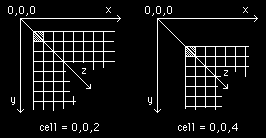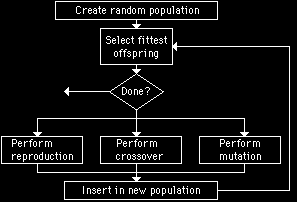LifeTools is a set of MaxMSP objects based on some Artificial Life basic algorithm functions. The Mutation and Crossover objects from LifeTools are inspired by the Mutate and Crossover objects written by Gary Lee Nelson (included in the old Rand external). However, instead of manipulating bit strings, LifeTools objects process Lists of integers. All objects run on MacOS9, MacOSX and Windows versions of MaxMSP.
CA
CA is a one dimensional cellular automaton. It is modeled as a linear row of cells where each cell has one of two possible states: alive or dead. The rules are based on proximity as each cell has two neighbors: left or right. For each generation, a cell sets its state anew according to predefined proximity rules. These rules can be set by selecting the CA object and choosing Get Info in the Max menu.
![]()
• Download CA for MaxMSP (MacOSX
Intel)
•
Download CA for MaxMSP (MacOSX)
• Download
CA for MaxMSP (Windows)
•
Download CA for MaxMSP (MacOS9)
Life / Life2x / LifeTorus
Life
is a cellular automaton based on Conway's Game of Life. It is modeled
as a 2D grid of cells and each cell has one of two possible states: alive
or dead. The rules are based on proximity as each cell has eight neighbors:
left, right, above, below, and on four corners. For each generation, a
cell sets its state anew according to the following two rules:
1- A dead cell becomes alive if it has exactly 3 live neighbors.
2- A live cell stays alive only if it has either 2 or 3 live neighbors.

• Download LifeTorus for MaxMSP (MacOSX Intel)
• Download LifeTorus for MaxMSP (MacOSX)
• Download LifeTorus for MaxMSP (Windows)
• Download Life2x for MaxMSP (MacOSX Intel)
• Download Life2x for MaxMSP (MacOSX)
• Download Life2x for MaxMSP (Windows)
• Download Life for MaxMSP (MacOS9)
Life3D / LifeGL
Like
the Life object, this cellular automaton is based on Conway's Game of
Life. It is modeled as a 3D grid of cells and each cell has one of two
possible states: alive or dead. The rules are based on proximity as each
cell has 26 neighbors. For each generation, a cell sets its state anew
according to the same two rules as the 2D Game of Life:
1- A dead cell becomes alive if it has exactly 3 live neighbors.
2- A live cell stays alive only if it has either 2 or 3 live neighbors.

• Download LifeGL for MaxMSP (MacOSX Intel)
• Download LifeGL for MaxMSP (MacOSX)
• Download LifeGL for MaxMSP (Windows)
• Download Life3D for MaxMSP (MacOS9)
Mutation
The Mutation object mutates a list of numbers based on random probabilities. This object offers 5 different mutation modes.

• Download Mutation for
MaxMSP (MacOSX Intel)
• Download Mutation for MaxMSP
(MacOSX)
•
Download Mutation for MaxMSP (MacOS9)
• Download
Mutation for MaxMSP (Windows)
Crossover
The Crossover object performs a crossover between two lists of integers to create 2 new children Lists. Each parent List is divided into n size segments. According to the crossover probability of each segment, the Crossover function swaps (or not) this segment between Parent A and Parent B.

• Download Crossover for MaxMSP (MacOSX Intel)
• Download Crossover for MaxMSP (MacOSX)
• Download Crossover for MaxMSP (MacOS9)
• Download Crossover for MaxMSP (Windows)
Evolve
Evolve is based on conventional genetic algorithm. It produces offsprings (new Lists) from an initial List of integers. The user selects which offspring he prefers (the fitness function is not part of the object) and new offsprings are generated using reproduction, mutation and crossover.

• Download Evolve for MaxMSP (MacOSX Intel)
• Download Evolve for MaxMSP (MacOSX)
• Download Evolve for MaxMSP (MacOS9)
• Download Evolve for MaxMSP (Windows)